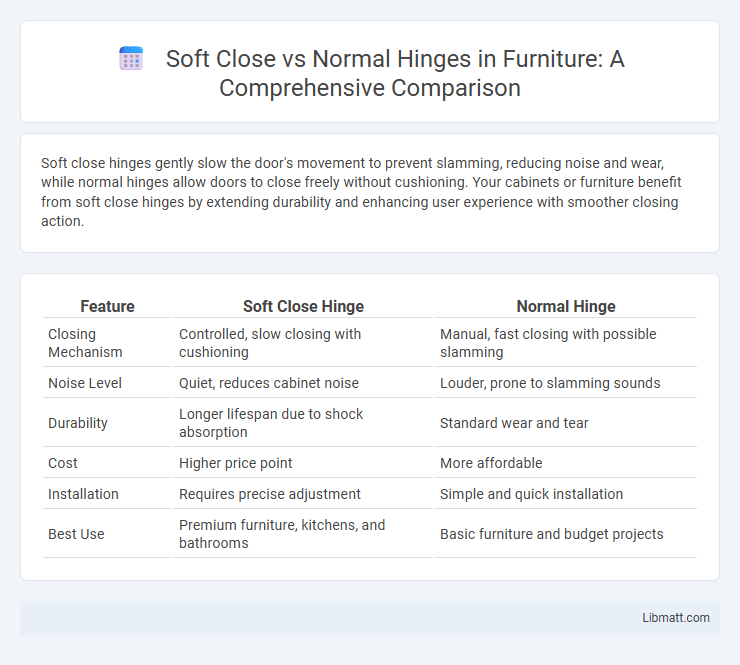Soft close hinges gently slow the door's movement to prevent slamming, reducing noise and wear, while normal hinges allow doors to close freely without cushioning. Your cabinets or furniture benefit from soft close hinges by extending durability and enhancing user experience with smoother closing action.
Table of Comparison
| Feature | Soft Close Hinge | Normal Hinge |
|---|---|---|
| Closing Mechanism | Controlled, slow closing with cushioning | Manual, fast closing with possible slamming |
| Noise Level | Quiet, reduces cabinet noise | Louder, prone to slamming sounds |
| Durability | Longer lifespan due to shock absorption | Standard wear and tear |
| Cost | Higher price point | More affordable |
| Installation | Requires precise adjustment | Simple and quick installation |
| Best Use | Premium furniture, kitchens, and bathrooms | Basic furniture and budget projects |
Introduction to Cabinet Hinges
Cabinet hinges play a crucial role in ensuring the smooth function and durability of your cabinetry. Soft close hinges gently slow the door's movement, preventing slamming and reducing wear, while normal hinges allow the door to close freely without this cushioning effect. Choosing between soft close and normal hinges impacts both noise levels and long-term maintenance in your kitchen or storage spaces.
What Are Soft Close Hinges?
Soft close hinges use hydraulic or spring mechanisms to gently close cabinet doors, preventing slamming and reducing noise. These hinges enhance the longevity of your cabinets by minimizing wear and tear compared to normal hinges, which rely on manual force and can cause abrupt closures. Choosing soft close hinges improves the overall user experience by offering smooth, controlled door movement.
What Are Normal Hinges?
Normal hinges, commonly known as standard hinges, are mechanical bearings that connect two objects, typically doors and frames, allowing rotational movement. These hinges operate without any damping mechanism, causing the door to close abruptly if not manually controlled. Standard hinges are valued for their simplicity, durability, and cost-effectiveness in various residential and commercial applications.
Key Differences Between Soft Close and Normal Hinges
Soft close hinges feature a damping mechanism that prevents cabinet doors from slamming shut, providing a smooth and quiet closing experience, while normal hinges lack this technology, resulting in louder, abrupt door closures. Soft close hinges enhance durability by reducing wear and tear on cabinets, whereas normal hinges may cause faster deterioration due to impact stress. Your choice between these hinges can affect both the longevity and noise level of your cabinetry.
Advantages of Soft Close Hinges
Soft close hinges provide superior noise reduction by preventing doors from slamming shut, enhancing the quietness of your living or working space. These hinges also minimize wear and tear on cabinets, extending their lifespan and maintaining a refined appearance. Your furniture benefits from smoother, safer operation, which adds both convenience and increased durability compared to normal hinges.
Drawbacks of Soft Close Hinges
Soft close hinges, while reducing noise and preventing slamming, often suffer from higher costs and increased installation complexity compared to normal hinges. Their internal damping mechanism can wear out over time, leading to diminished performance and potential failure. Maintenance and replacement of soft close hinges can be more challenging, especially in heavy-use environments where durability is critical.
Pros and Cons of Normal Hinges
Normal hinges offer straightforward installation and affordability, making them a popular choice for many cabinetry applications. Their durability suits heavy doors, but they lack the smooth, silent closing mechanism found in soft close hinges, often resulting in louder, sometimes abrupt door closure. Maintenance is generally minimal, though normal hinges may require occasional tightening or lubrication to prevent squeaking and ensure optimal function.
Cost Comparison: Soft Close vs Normal Hinges
Soft close hinges typically cost between $10 to $25 per piece, offering enhanced functionality by preventing cabinet doors from slamming shut. Normal hinges are more budget-friendly, averaging around $2 to $8 each, making them suitable for basic applications without noise reduction features. Your choice depends on whether the added expense of soft close hinges justifies the investment in quieter, smoother closing performance.
Installation Process and Compatibility
Soft close hinges offer a smoother installation experience with click-on mounting plates that simplify alignment and reduce installation time compared to traditional normal hinges, which often require precise screw placement and adjustments. Soft close hinges are designed to be compatible with standard cabinet frames and doors but may require specific mounting plates or door thicknesses to function correctly, whereas normal hinges have broader compatibility across various cabinet styles without special requirements. Your choice should consider installation convenience and whether your cabinet doors meet the compatibility standards needed for soft close mechanisms.
Which Hinge Is Right for Your Needs?
Soft close hinges prevent cabinet doors from slamming shut by using hydraulic damping, ensuring quieter and smoother operation, ideal for kitchens where noise reduction is important. Normal hinges offer a more traditional door movement without built-in cushioning, often favored for budget-friendly projects or where soft close features are unnecessary. Your choice depends on your preference for noise control, durability, and budget considerations in your cabinetry.
Soft close vs normal hinge Infographic

 libmatt.com
libmatt.com